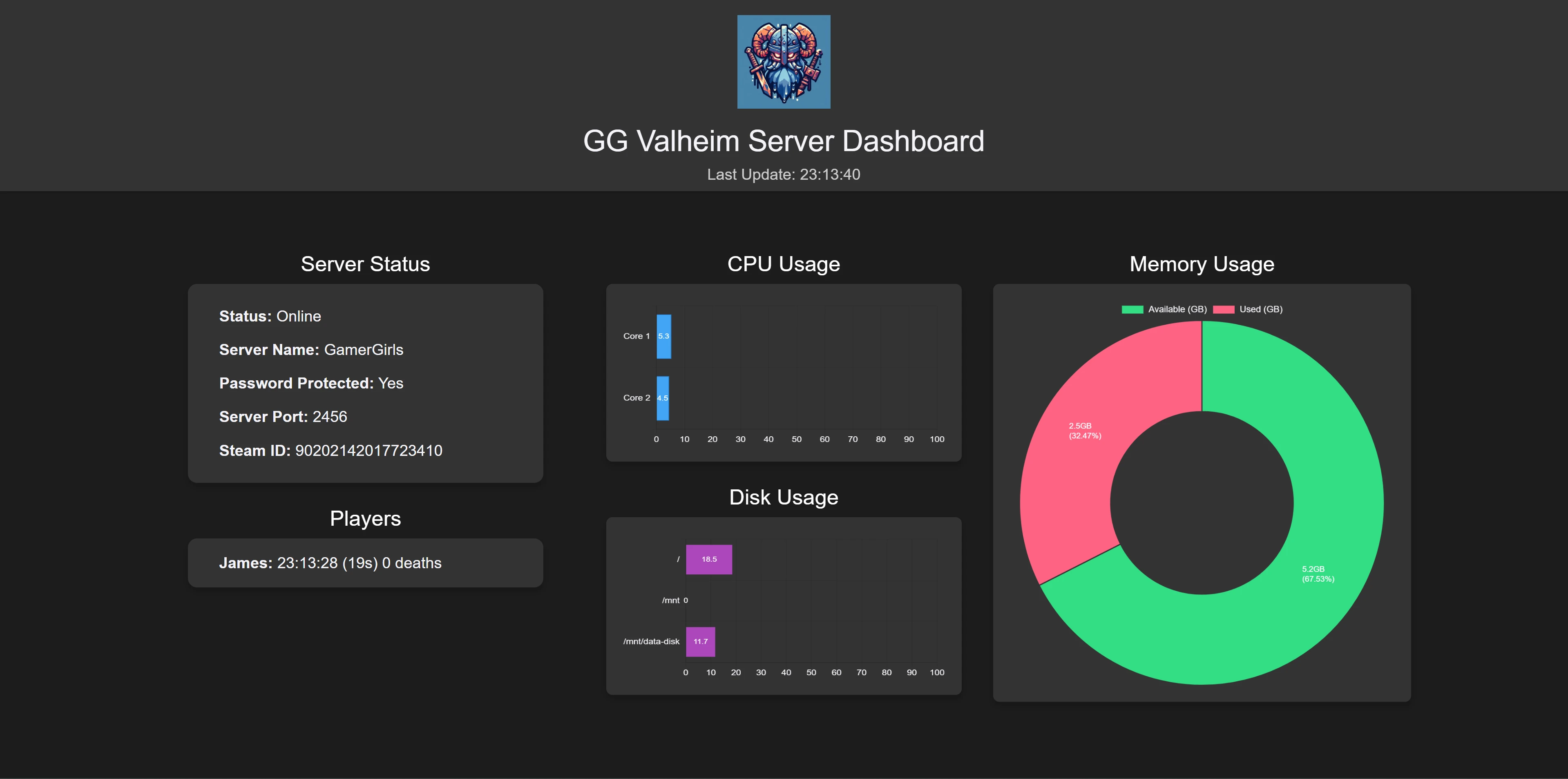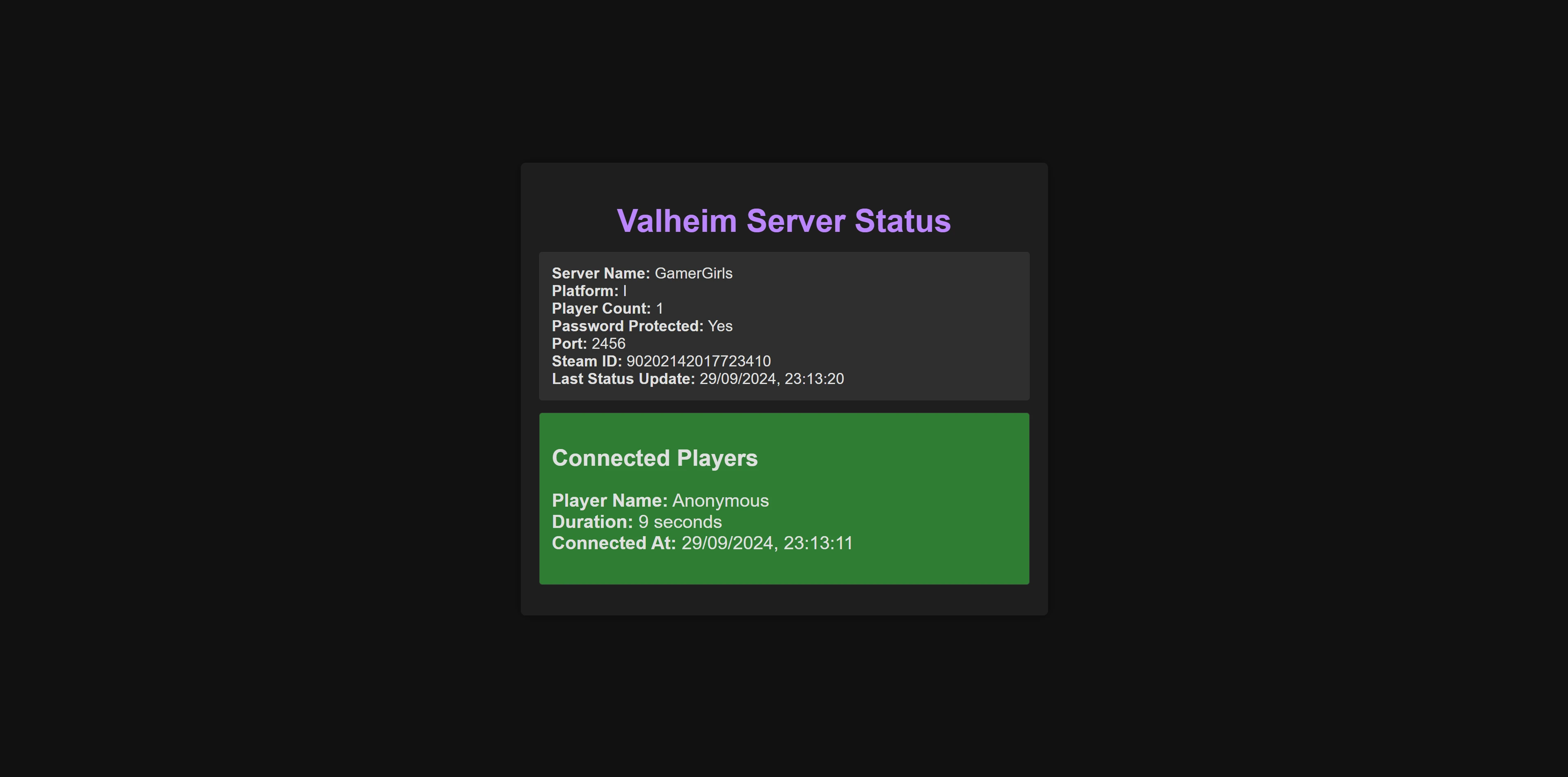This repository contains the code and scripts used to monitor and display real-time status and metrics for a dedicated Valheim game server.
The dashboard is hosted at ggserver.cc and provides live updates about server health, player activity, and system resource usage.
- GG Valheim Server Dashboard
The GG Valheim Server Dashboard is a web-based interface designed to track the status of a Valheim game server, including player activity and server resource consumption. It leverages real-time data to ensure players and server admins can stay informed about the server's health and performance.
- Displays key server details, including:
- Server Name
- Player Count
- Password Protection Status
- Steam ID
- Port
- Shows error messages if the server is not responding or still starting up.
- Data is sourced from the
status.jsonfile, which is automatically generated by the Valheim Server Docker Image (more details in the Status Web Server documentation).
- Displays details about currently connected players, including:
- Player Names
- Connection Times (localized)
- Session Durations
- Death Count
- Player data is fetched from the
player_data.jsonfile, which is generated by a custom Python script that parses server logs.
- Provides real-time charts for:
- CPU Usage (per core)
- Disk Usage
- Memory Usage
- Metrics are sourced from the
metrics.jsonfile, updated every minute by a Python script triggered via a systemd timer.
- The dashboard automatically refreshes every 10 seconds, ensuring the displayed data is always up-to-date.
- When the required JSON files (
status.json,player_data.json,metrics.json) are unavailable or inaccessible, the system gracefully handles the error by showing appropriate fallback messages or using placeholder data (with a red background). This ensures the dashboard remains functional and informative, even in case of server issues.


The status.json file is generated by the lloesche/Valheim Server Docker Image when the STATUS_HTTP=true environment variable is set.
The file is updated every 10 seconds and contains key details about the server's current status.
- Example of
status.jsoncontent:
{
"last_status_update": "2021-03-07T21:42:16.076662+00:00",
"server_name": "My Docker based server",
"player_count": 1,
"password_protected": true,
"port": 2456,
"steam_id": 90143789459088380,
"players": [
{
"name": "",
"duration": 7.000421047210693
}
]
}This file is publicly accessible and served via a web server running on the Docker container, which is configured to run on port 80 by default.
More details are available in the lloesche Status Web Server documentation.
This file is dynamically generated by a Python script that parses the server logs inside the Docker container. The script runs as a systemd service on the Azure VM.
- Example of
player_data.json:
{
"Player1": {
"connection_time": "2024-09-29T12:34:56Z",
"death_count": 2
}
}The metrics.json file is created by a Python script running via a systemd timer on the VM. It contains resource usage data such as CPU, memory, and disk usage, updated every minute.
- Example of
metrics.json:
{
"cpu": {
"per_core_percent": [15, 25, 30]
},
"disk": {
"disk_1": {
"percent": 50,
"used_bytes": 5000000000,
"total_bytes": 10000000000
}
},
"memory": {
"total_bytes": 16000000000,
"used_bytes": 8000000000
}
}- Server: The dedicated Valheim server is hosted on an Azure VM running Linux (Ubuntu). The Docker container for the Valheim server is based on the lloesche/valheim-server-docker image.
- Domain: The domain ggserver.cc is managed and proxied via Cloudflare.
- Python Scripts:
- One script monitors and parses the logs from the Docker container to generate
player_data.json. - Another script collects system metrics (CPU, memory, disk) and generates
metrics.json.
- One script monitors and parses the logs from the Docker container to generate
-
Frontend:
- HTML/CSS/JavaScript for the user interface.
- Chart.js and Chart.js DataLabels Plugin for visualizing CPU, memory, and disk metrics.
-
Backend:
- Python scripts for log parsing and system metric collection.
- Docker container running the Valheim server.
-
Hosting:
- Azure VM for server hosting.
- Cloudflare for domain management and proxying.
To set up a similar Valheim server dashboard, follow these steps:
- Clone or pull the Valheim Docker Image and configure it with
STATUS_HTTP=trueto enable the status web server. - Set up the necessary Python scripts to:
- Parse Valheim server logs and generate
player_data.json. - Collect system metrics and generate
metrics.json.
- Parse Valheim server logs and generate
- Host the dashboard using a web server such as Caddy, Nginx or Apache.
